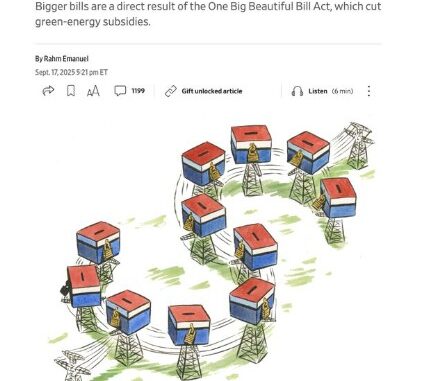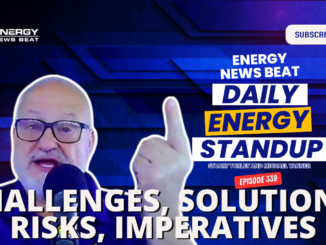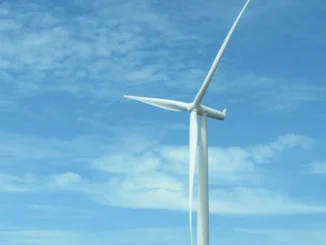
In a recent opinion piece in The Wall Street Journal, former Democratic operative Rahm Emanuel blames rising U.S. electricity prices on President Trump and his “One Big Beautiful Bill Act,” claiming it slashed green-energy subsidies and stalled projects, leading to supply shortages and higher bills for consumers. Emanuel argues that Trump’s policies prioritize political vendettas—like his alleged disdain for wind turbines—over practical energy expansion, predicting voter backlash in the 2026 midterms.
He points to a 10% price jump since January and stalled clean-energy investments as evidence that Republicans are to blame for “mounting utility bills.”But Emanuel and the WSJ are dead wrong—again. A closer look at the data reveals that the states with the highest electricity prices are overwhelmingly run by Democrats, where aggressive Net Zero and climate crisis policies have driven up costs through mandates, subsidies, and regulatory burdens. Far from Trump’s doing, these blue-state experiments in “green” energy are the real culprits behind skyrocketing rates, punishing ratepayers with unreliable renewables and inflated taxes. Let’s break it down with the facts.
The Real Picture: Blue States Dominate the List of Highest Electricity Prices
If Trump’s policies were truly to blame for national price hikes, we’d expect uniform increases across the board—or at least spikes in red states. Instead, the top 15 states with the highest residential electricity rates as of late 2024 and early 2025 are predominantly Democrat-led, according to multiple sources including the U.S. Energy Information Administration (EIA) and independent analyses.
Here’s a snapshot of the top 15 states by average residential electricity price (cents per kWh), based on recent data:
|
Rank
|
State
|
Average Rate (cents/kWh)
|
Governor’s Party
|
|---|---|---|---|
|
1
|
Hawaii
|
39.36-41.11
|
Democrat (Josh Green)
|
|
2
|
Connecticut
|
27.64-32.55
|
Democrat (Ned Lamont)
|
|
3
|
California
|
26.69-33.52
|
Democrat (Gavin Newsom)
|
|
4
|
Alaska
|
25.65-27.30
|
Republican (Mike Dunleavy)
|
|
5
|
New York
|
25.02-26.18
|
Democrat (Kathy Hochul)
|
|
6
|
Rhode Island
|
~25.00 (estimated from trends)
|
Democrat (Dan McKee)
|
|
7
|
Massachusetts
|
~24.00-28.00
|
Democrat (Maura Healey)
|
|
8
|
New Hampshire
|
~23.00-25.00
|
Republican (Kelly Ayotte, recent election)
|
|
9
|
Vermont
|
~22.00-24.00
|
Republican (Phil Scott)
|
|
10
|
Maine
|
~21.00-23.00
|
Democrat (Janet Mills)
|
|
11
|
Michigan
|
~19.00-21.00
|
Democrat (Gretchen Whitmer)
|
|
12
|
New Jersey
|
~18.00-20.00
|
Democrat (Phil Murphy, term ending)
|
|
13
|
Maryland
|
~17.00-19.00
|
Democrat (Wes Moore)
|
|
14
|
Nevada
|
~16.00-18.00
|
Republican (Joe Lombardo)
|
|
15
|
Arizona
|
12.98-15.28
|
Democrat (Katie Hobbs)
|
(Sources: Compiled from EIA data, SaveOnEnergy, QuickElectricity, and Statista reports for 2024-2025 averages.)
Of these, at least 11 have Democratic governors, representing a clear pattern: Blue states pay more.In contrast, red states like Idaho (12.28 cents/kWh), North Dakota, and Utah boast some of the lowest rates, often relying on abundant fossil fuels and fewer mandates.
This isn’t a coincidence—it’s policy.
Why Blue States’ Prices Are Skyrocketing: Net Zero Policies at Fault
Democrat-run states have embraced aggressive climate agendas, including Renewable Portfolio Standards (RPS) that mandate a certain percentage of energy from wind, solar, and other “clean” sources. These policies sound noble, but they come with a hefty price tag for consumers.
Renewable Mandates Drive Up Costs: States with strict RPS, like California and New York, force utilities to integrate intermittent renewables, which require expensive backups (often natural gas) to maintain grid reliability. A Heritage Foundation analysis shows that blue states with these mandates pay significantly more for electricity, as they inflate the costs of traditional power sources like coal and gas through regulations and subsidies.
Research from the Center of the American Experiment and others confirms RPS hikes residential bills by 31.9% on average compared to non-RPS states.
Taxes, Subsidies, and Regulations Add to the Burden: In densely populated Democratic strongholds like New Jersey and California, high distribution costs, renewable subsidies, and green taxes pile on. Energy News Beat reports that New Jersey’s 49% natural gas and 45% nuclear mix should keep prices low, but Democratic policies inflate them through taxes and infrastructure mandates.
Similarly, California’s push for Net Zero has led to the highest mainland U.S. rates, with unemployment and poverty compounding the issue as companies flee high energy costs.
Net Zero’s Broader Impact: Pursuing zero emissions by 2050 doubles electricity demand while stranding reliable sources, according to reports from the Discovery Institute. In Washington and Oregon—both blue-leaning—Net Zero plans could add $550 billion in costs, hitting households hard.
The Institute for Energy Research notes that states and countries with heavy renewable pushes face “significantly higher rates,” while blaming Trump ignores these long-standing blue-state failures.
Even Bloomberg, often sympathetic to green policies, acknowledges that data centers (fueled by AI demand) are pushing prices up in high-demand areas, but this exacerbates existing issues in mandate-heavy states.
Energy News Beat highlights how Dem-led states’ renewable obsessions spark voter anger, with leaders scrambling to shift blame.
Critics might point to studies claiming no direct link between renewables and higher prices, arguing factors like fuel costs or infrastructure play bigger roles.
But these often overlook the full cost of subsidies and grid upgrades required for intermittency. When you factor in the subsidies taxpayers foot for wind and solar—totaling billions—the correlation becomes clear: More mandates mean more expense.
Trump’s Policies: A Path to Lower Prices?
Emanuel’s WSJ screed ignores that Trump’s bill aimed to cut wasteful subsidies that prop up inefficient renewables, potentially freeing up resources for reliable energy like natural gas and nuclear. Red states like Texas have expanded “all-of-the-above” energy without mandates, greening the grid while keeping rates affordable.
If anything, rolling back blue-state-style overregulation could lower prices nationwide.
Voters are noticing: In races like New Jersey’s gubernatorial contest, electricity costs are jolting politics, with residents fed up with Democratic policies.
As Energy News Beat warns, electricity inflation from Net Zero could be the next financial crisis, hitting blue states hardest.
The WSJ’s attempt to pin rising prices on Trump is just another partisan hit job. The data is undeniable: Democrat-run states’ climate crusades are the real reason your bill is climbing. It’s time to ditch the Net Zero fantasy and embrace affordable, reliable energy for all Americans.
Got Questions on investing in oil and gas? Or do you have a Tax Burden in 2025?
Crude Oil, LNG, Jet Fuel price quote
ENB Top News
ENB
Energy Dashboard
ENB Podcast
ENB Substack






